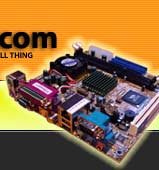|
Chyang Fun E-Note Review
Posted on January 26, 2003
Switching on with the lid attached, there is a definite whooshing sound as air passes through the PSU and into case. The PSU fan is identified as the culprit - time to have a closer look.
The 50 x 80 x 145mm PSU supplied is a 150W Chyang Fun "CWT-150FATX12", running at 230V. In 110V markets, a different model will be supplied (we do not currently know the specifications of this).
Opening the PSU (and invalidating the warranty) to reveal the PSU fan. It is a 40x40x15mm ADDA AD0412HS-D50 running at a frightening 8000RPM and producing an airflow of 9.2CFM. We pondered methods of lowering the volume of the fan (39.3dB/A) to something more reasonable - replacement seems the best option (although Bo Christensen lowered his to 5V operation - see part II of this review for his methods). We looked at the current range of ADDA fans, and allowing that there is room for a 20mm wide fan inside the PSU, there are several potential replacements. The 40x40x20mm AD0405HX-C50 produces 9.2CFM at 31db/A for instance. Another cunning way of cooling the PSU could be with larger, slower side-mounted fans. Considering the EPIAs are designed with low-noise and low-power in mind, we do wonder why Chyang Fun couldn't use a quieter PSU. The answer of course, is printed on the fan itself - this is a P4 motherboard capable PSU and overspecced for the job. At least there is space inside to replace the PSU with something quieter.
Time for a closer look at the PCI blanking plate. It looks a little undersized.
Removing the plate confirms our suspicions. This is an XCard, for size comparison. As with most PCI cards, the metal plate can be unscrewed with a small pair of pliers. Unless a shorter replacement plate has been provided, the card will have an airgap at the back of the case.
Herein lies our major gripe. The card plainly doesn't fit.
Well, some cards do - here's a Gainward Geforce 4 card fitting in snugly, with its backplate removed. Careful measurement revealed the Gainward to be 64mm high from the base of card to the top, with unused space of 14mm above that where the shortened blanking plate was. A few extra mm may be possible with a hacksaw, but there's basically 78mm of room for any PCI card. The XCard (a typically dimensioned card) measured 90mm.
Another possible suggestion (thanks Jeff!) would be to fit the PCI card parallel with the motherboard on its side using a tall riser card - this would involve some cutting, but where there's a will, there's a Dremel.
Time to switch on the power again. The LED refracts through the Plexiglass in a rather pleasing manner. The switches have a solid feel to them.
Conclusion
We like the look of this case - a lot. It is the classiest of all the cases we've reviewed to date, mixing Aluminium and Plexiglass in a unique and distinctive way. It wouldn't look out of place in any living room, or next to a TFT on a glass-topped desk. But it deserves a quieter PSU, and should be 15mm taller to accomodate all PCI cards, not just a select few. Having said that, the EPIA M motherboard *is* an all-in-one solution and not everyone will even need a PCI card, and the PSU *is* replaceable and potentially made quieter. We suspect strategically placed acoustic padding would also be very effective at reducing PSU fan noise.
Now Read Part II - Silencing an E-Note
Bo Christensen demonstrates how, with a few simple (and some not so simple) modifications an E-Note case can be near-silenced.
|







